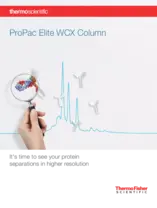The ProPac™ product range, manufactured by Thermo Scientific™, consists of various HPLC columns for ion-exchange, hydrophobic interaction and affinity chromatography. They are suitable for the analysis of diverse biological samples containing proteins, peptides and other biomolecules.
The ProPac™ SAX-10, WAX-10, SCX-10, SCX-20 and WCX-10 protein columns are ion exchange columns designed specifically to provide high-resolution and high efficiency separations of proteins and glycoproteins (pI = 3‒10, MW>10,000 DA). The stationary phase is composed of 10 µm, non-porous ethylvinylbenzene-divinylbenzene copolymer beads which are surrounded by a highly hydrophilic, neutral polymer to reduce non-specific interactions between the surface and the biopolymer. The surface is grafted with the respective functional groups.
Thermo Scientific's ProPac™ PA1 LC columns enable the analysis and purification of hydrophilic anionic proteins and peptides. These strong anion-exchange columns provide high-resolution separations of proteins with pI values from 3 to 11. A pellicular packing ensures high-efficiency and fast mass transport.
ProPac™ HIC-10 are columns for high-resolution separations of proteins and peptides under non-denaturing conditions via Hydrophobic Interaction Chromatography (HIC). The stationary phase is based on 5 µm, high-purity silica particles.
ProPac™ IMAC-10 are special columns for "Immobilized Metal Affinity Chromatography" (IMAC). IMAC is a specialty technique used primarily for the purification of proteins that contain surface-exposed histidine residues and for enrichment of phosphopeptides. It is based on a reversible interaction between metal-binding sites on the protein with metal bound to a stationary phase. The stationary phase is composed of 10 μm, nonporous, styrene-divinylbenzene beads coated with a hydrophilic layer, to eliminate secondary hydrophobic interactions with the proteins. This hydrophilic layer has linear acrylate chains with pendant iminodiacetate (IDA) groups grafted to it. The poly(IDA) grafts are converted to metal-containing nanoparticles when the column is charged with metal. It is these nanoparticles that act as the IMAC interaction sites for individual proteins.


 Thermo ProPac Elite WCX HPLC Life Science Brochure
Thermo ProPac Elite WCX HPLC Life Science Brochure
 Thermo ProPac HIC 10 HPLC Life Science Brochure
Thermo ProPac HIC 10 HPLC Life Science Brochure
 Thermo ProPac IMAC 10 HPLC Life Science Brochure
Thermo ProPac IMAC 10 HPLC Life Science Brochure
 ProPac PA1 Columns Product Manual
ProPac PA1 Columns Product Manual
 Thermo ProPac SCX-20 Product Manual
Thermo ProPac SCX-20 Product Manual
 Thermo ProPac WAX-10, ProPac SAX-10 Product Manual
Thermo ProPac WAX-10, ProPac SAX-10 Product Manual
 Thermo ProPac WCX-10, ProPac SCX-10 Product Manual
Thermo ProPac WCX-10, ProPac SCX-10 Product Manual
 Thermo Propac Elite WCX pH Gradient Analysis of IgG1 HPLC Life Science Applications
Thermo Propac Elite WCX pH Gradient Analysis of IgG1 HPLC Life Science Applications
 Thermo Propac Elite WCX Therapeutic Protein Analysis HPLC Life Science Applications
Thermo Propac Elite WCX Therapeutic Protein Analysis HPLC Life Science Applications